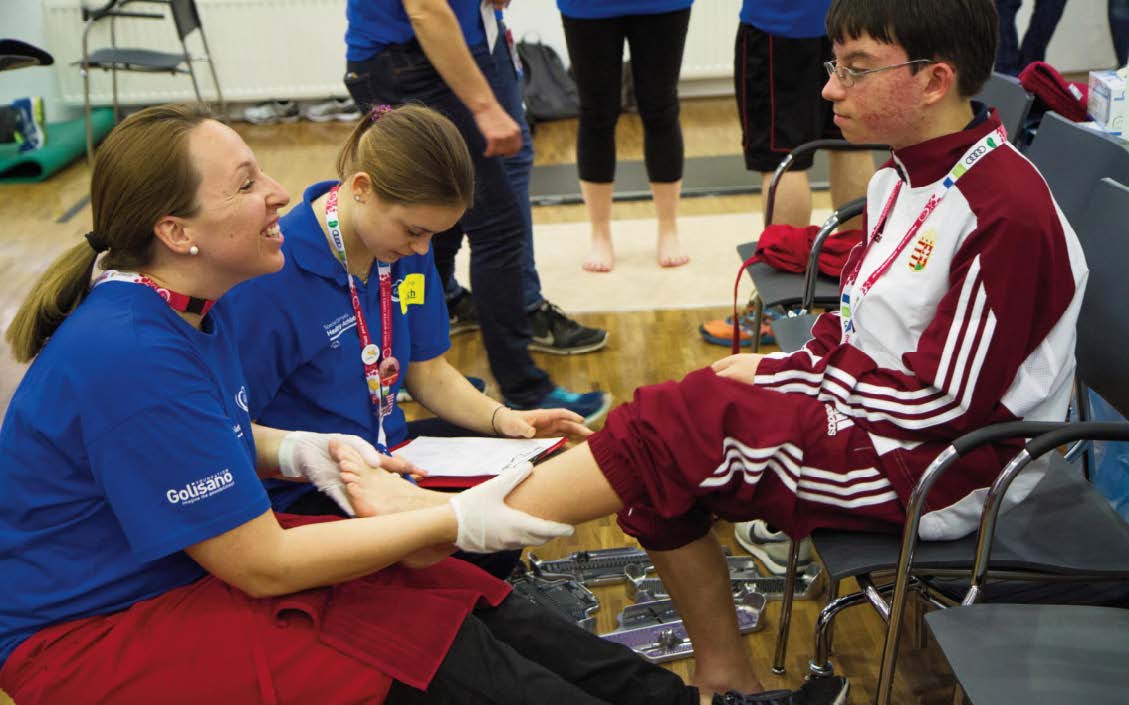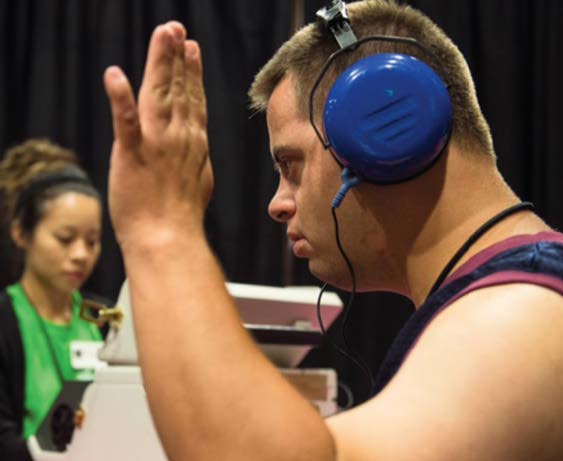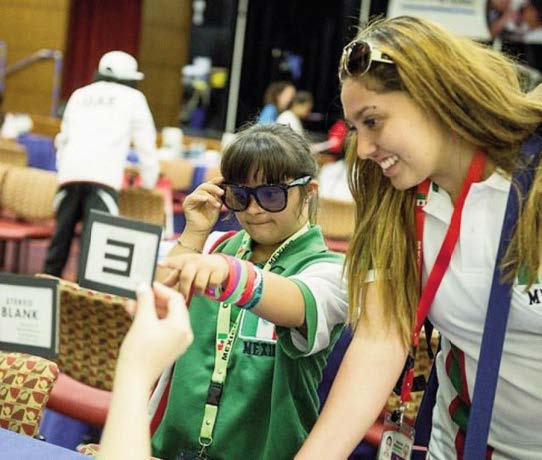
BY MEAGHAN MCHUGH, MPH, PHD
Ask an individual with intellectual disabilities (ID), who is also a Special Olympics athlete, to finish the statement, "Let me win", you will undoubtedly hear the reply, "…but if I cannot win, let me be brave in the attempt." This oath speaks to the strength and competitive spirit of the 5 million Special Olympics athletes all over the world. Unfortunately, some of our athletes' battle more than just an opponent, many individuals with ID suffer from undetected health concerns and inadequate access to health services. Barriers to access to care include limited numbers of health care providers willing and able to provide care, as well as health facilities and health information that have not taken into consideration the needs of individuals with ID. This is where Healthy Athletes comes in.


SCREEN STARS: (Opposite page) An athlete attends a Fit Feet Healthy Athletes Screening at the 2017 World Winter Games. (Above, left to right) Special Olympics Southern California basketball player Timothy Riemann gets a hearing examination at Healthy Hearing; Michelle Falcon, a swimmer from Mexico, has her vision examined at Opening Eyes.
SPECIAL OLYMPICS HEALTHY ATHLETES PROGRAM
Since 1997, Healthy Athletes has offered more than 2.1 million person-centered health screenings in over 135 countries around the world. The program is dedicated to providing appropriate health services and health education to Special Olympics athletes while changing the way health systems interact with people with ID. The overall goal of Special Olympics Health, made possible by the Golisano Foundation, is to reach a 'tipping point' so that all indi viduals with ID have access to quality health services and programs. Specifically, Special Olympics seeks to increase access to health care for 11 million people with ID by 2020 ("11 by 20"). Special Olympics has several strategies to reach this goal, one of them is Healthy Athletes.
UNDETECTED HEALTH CONCERNS
Individuals with ID are often at greater risk for chronic health issues such as diabetes.1,2 Through Healthy Athletes, health professionals are trained to work with ath letes, to use effective communication techniques, and to create a more welcoming space for patients with ID. During the Special Olympics USA Games in Seattle, Washington (July 2018), 1,762 athletes received at least one health screening with most athletes receiving 4 of the 7 screenings offered (Healthy Athletes conducted 7,125 health screenings in total). The screenings uncovered some concerning statistics, including that 42% of the participating adults with ID screened for height and weight (BMI) were found to be obese.3
HEALTHY ATHLETES IS COMPRISED OF 8 DISCIPLINES THAT FOCUS ON A DIFFERENT ASPECT OF AN ATHLETE'S HEALTH
fit feet: A program to help alleviate treatable and preventable conditions by evaluating problems of the feet, ankles and lower extremity biomechanics.
funfitness: A physical therapy event that examines for flexibility of hamstring, calf, shoulder rotator and hip flexor muscles; functional strength of the abdominal and lower extremity muscles, and for balance.
health promotion: (BMI, Blood Pressure, Bone Density, Healthy Habits, and Tobacco Avoidance): This discipline uses interactive educational tools and displays, motivational literature and demonstrations to raise the awareness of Special Olympics athletes about the need to improve and maintain an enhanced level of wellness and self-care.
healthy hearing: Provides free hearing screenings and other medical services, including ear wax removal, swim molds, hearing aid maintenance and minor repairs.
opening eyes: Provides free eye assessments, prescription eyewear, sunglasses and sports goggles through a 12-station vision evaluation.
special smiles: Provides comprehensive oral health care information, dental screenings and instructions on correct brushing and flossing techniques.
strong minds: Offers interactive learning activities focused on developing adaptive coping skills to help athletes develop active strategies for maintaining emotional wellness under stress, such as thinking positive thoughts, releasing stress and connecting with others.
medfest: Provides a physical exam that all athletes need prior to participating in Special Olympics sports. Screenings assess blood pressure, temperature, pulse, height, weight, body mass index, vision, hearing, medical history, potential medication side effects and general physical health.
In the general population, it is estimated that about 35% of adults are obese.3 In addition, about 15% reported blood pressure rates that suggested hypertension with 18% of athletes arriving to compete with untreated tooth decay.
In addition to receiving high quality health screenings from trained professionals, Healthy Athletes offers individuals with ID appropriate health education. For example, within the Special Smiles venue, athletes are provided information on how to effectively brush and floss their teeth. They also have an opportunity to practice on models provided onsite. Within the Health Promotion venue, athletes have an opportunity choose to change one unhealthy behavior to a healthier one – such as eating five fruits and vegetables each day. Athletes are encouraged to choose from a variety of healthy behaviors, and they leave the venue with a card reminding them of their healthy choice.
During the health screenings within Healthy Athletes, it is not uncommon for medical professionals to find undetected and often preventable health concerns. For example, during the USA games, an athlete experienced mouth pain during the flight to Seattle. Upon arriving at the games, he was given antibiotics for an abscessed tooth (an abscessed tooth is a pocket of pus that can form in parts of the tooth due to a bacterial infection). Left untreated, an abscessed tooth can become serious and potentially life threatening. The athlete was screened at Healthy Athletes and, due to a partnership between Special Olympics and the Pacific Dental Foundation, the adult with ID received on-site dental care.
EMPOWERMENT
One of the most powerful aspects of the Healthy Athlete program is that during the screenings, individuals with ID have an opportunity (and a responsibility) to teach health professionals how to effectively work with adults with ID. This offers a chance for athletes to be teachers, to mentor the professionals, and to help shape the health message. For example, Special Olympics athletes have taught us to ask medical professionals to think about using simpler language and to slow the pace at which they speak. Athletes have an intellectual disability of varying degrees, but they are not all necessarily hard of hearing – speaking louder won't make them understand better. Athletes have taught us that they prefer to know what is going to happen during the health screening, so professionals are asked to describe what they will be doing and perhaps the next one or two steps that will follow. One of the clearest and most consistent messages athletes have taught us is not to speak down to them but to get to know them, smile and make the experience fun!
Special Olympics is open to individuals with ID of all ages starting in the early years (Young Athletes) and extending well into adulthood (78+ years young). The Healthy Athletes program is just one program offered by Special Olympics to support individuals with ID so they might be "brave in their attempt". To find out more about how you can become involved in Special Olympics Healthy Athletes program, visit specialolympics.org/programs •
ABOUT THE AUTHOR: Meaghan McHugh, MPH, PhD is the Director of Healthy Athletes at Special Olympics.
References 1. Balogh et al. Disparities in Diabetes Prevalence and Preventable Hospitalizations in People with Intellectual and Developmental Disability: A Population-Based Study. Diabetic Medicine. 32: 235-242. 201 2. Bregholdt R, Eising S, Nerup J, Pocoit F. Increased Prevalence of Down Syndrome in Individuals with Type 1 Diabetes in Denmark: A Nationwide Population-Based Study. Diabetologia. 49:1179. 2006 3. Flegal, K. M., Carroll, M. D., Kit, B. K., & Ogden, C. L. (2012). Prevalence of obesity and trends in the distribution of body mass index among US adults, 1999-2010. Jama, 307(5), 491-497.